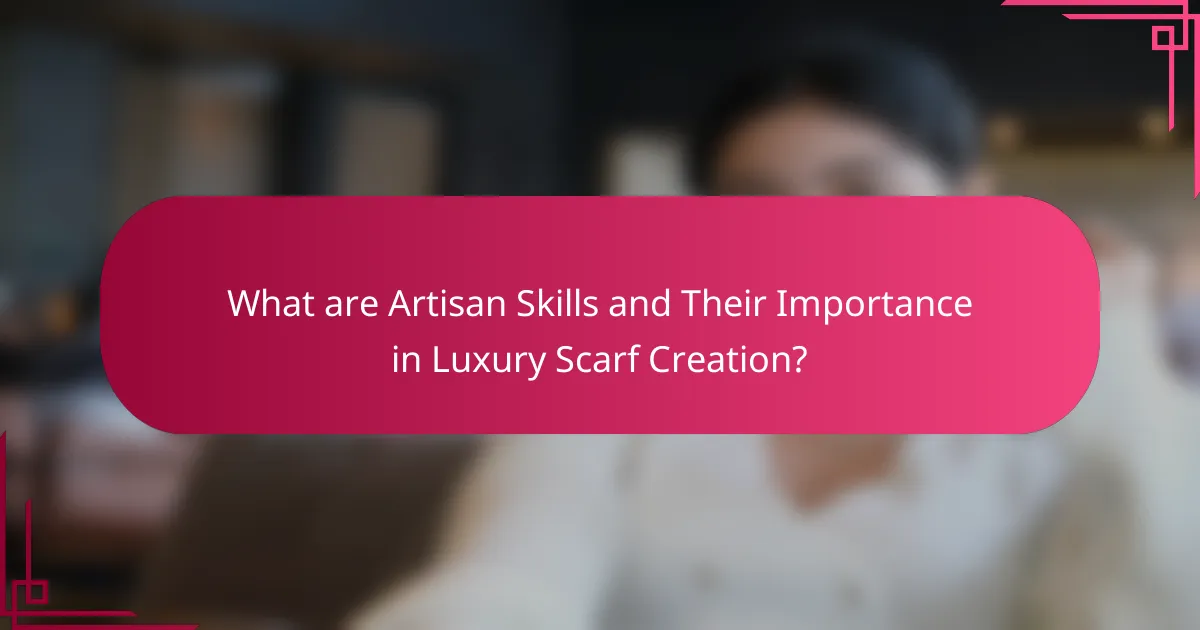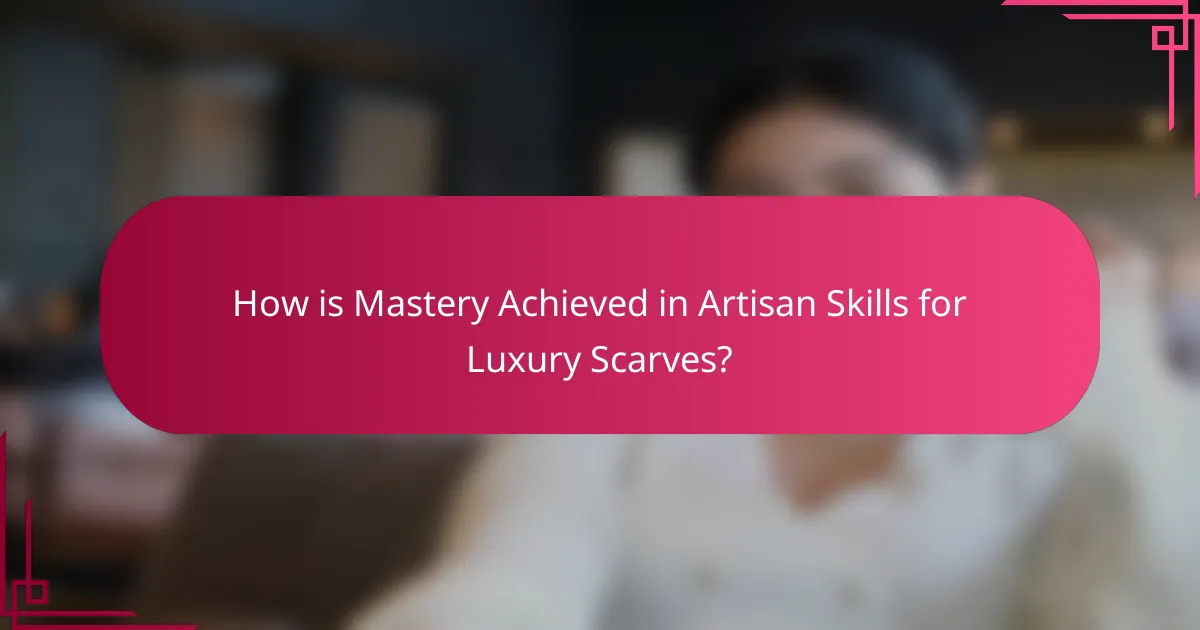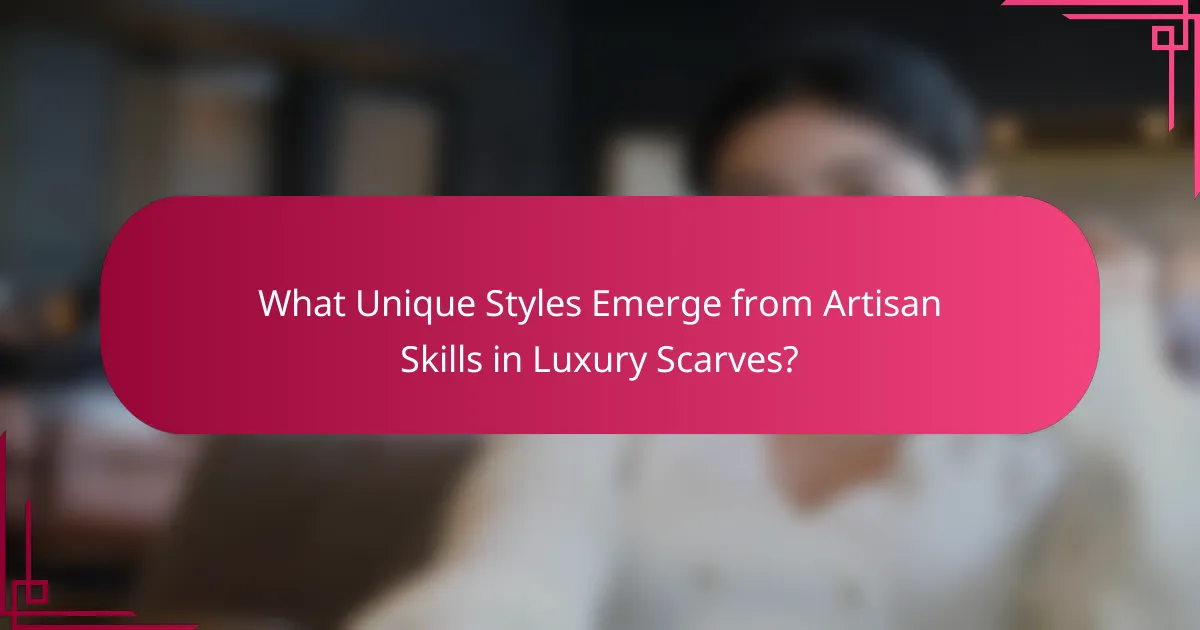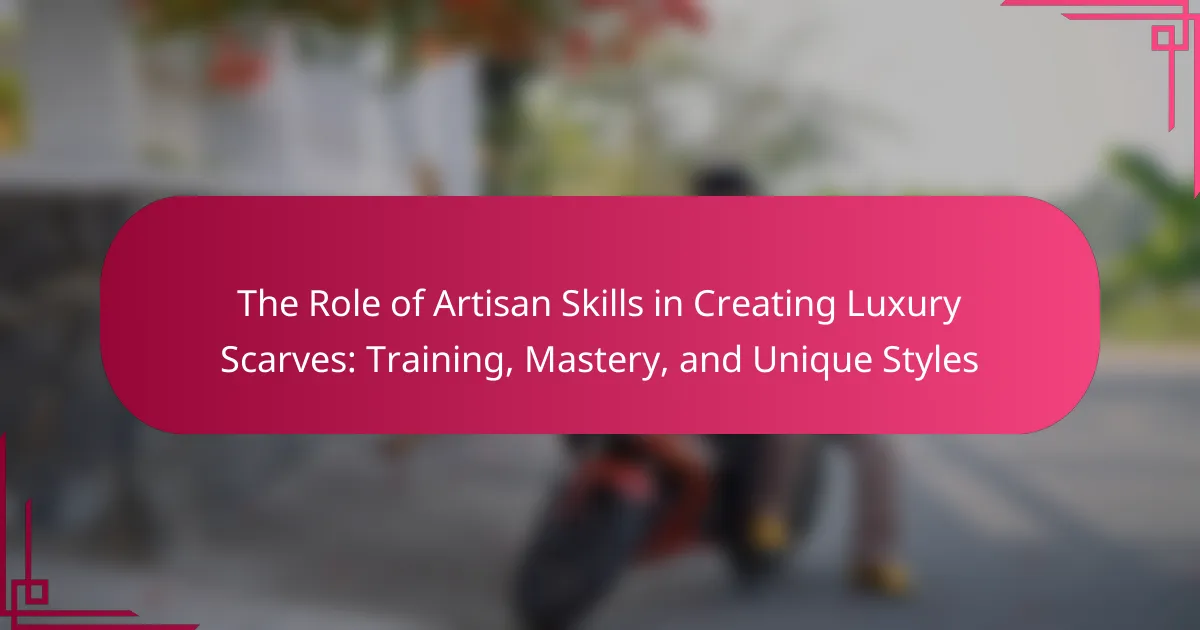Artisan skills encompass specialized techniques and craftsmanship essential for creating luxury scarves, including weaving, dyeing, and embroidery. These skills are honed through extensive training and apprenticeships, enabling artisans to achieve mastery that results in high-quality, durable, and aesthetically appealing products. Unique styles emerge from these artisan techniques, featuring intricate patterns, innovative materials, and cultural heritage, which enhance the exclusivity and artistry of each scarf. The meticulous nature of this craftsmanship not only ensures functionality but also elevates the luxury scarf market by appealing to consumers who value quality and uniqueness.

What are Artisan Skills and Their Importance in Luxury Scarf Creation?
Artisan skills are specialized techniques and craftsmanship used in the creation of luxury scarves. These skills include weaving, dyeing, and embroidery, which require extensive training and practice. Master artisans often possess unique attributes that set their work apart, such as intricate patterns or innovative materials. The importance of these skills lies in their ability to enhance the quality and aesthetic appeal of the scarves. High-quality artisan techniques contribute to the durability and exclusivity of luxury scarves. Furthermore, they often reflect cultural heritage and artistry, adding value to the final product. The meticulous nature of artisan work ensures that each scarf is not only functional but also a work of art. This craftsmanship ultimately elevates the luxury scarf market by appealing to discerning consumers who appreciate quality and uniqueness.
How do artisan skills differentiate luxury scarves from mass-produced options?
Artisan skills differentiate luxury scarves from mass-produced options through superior craftsmanship and attention to detail. Luxury scarves often feature hand-rolled edges and intricate patterns that require skilled artisans. These artisans typically undergo years of training to master techniques such as weaving, dyeing, and embroidery. In contrast, mass-produced scarves rely on automated processes that lack the personal touch and uniqueness of handmade items.
The use of high-quality materials is also a hallmark of artisan-made scarves. For example, luxury scarves may use fine silks or cashmere, while mass-produced options often use synthetic blends. Artisan production can result in limited editions, enhancing exclusivity. Historical examples include brands like Hermès, known for their handcrafted silk scarves, which maintain a legacy of artisan skill.
Overall, the combination of skilled labor, quality materials, and unique designs sets luxury scarves apart from their mass-produced counterparts.
What specific techniques are considered artisan skills in scarf making?
Artisan skills in scarf making include techniques such as hand weaving, dyeing, and embroidery. Hand weaving involves creating fabric on a loom, allowing for intricate patterns. Dyeing techniques like shibori and batik add unique color patterns to the fabric. Embroidery enhances the scarf’s design through detailed stitching. Other skills include knitting and crocheting, which provide different textures. Each technique requires specialized training and mastery. These skills contribute to the craftsmanship that defines luxury scarves. Master artisans often use traditional methods passed down through generations. The combination of these techniques results in unique, high-quality scarves.
Why is craftsmanship vital in the luxury fashion industry?
Craftsmanship is vital in the luxury fashion industry because it ensures high-quality products. Luxury brands rely on skilled artisans to create unique and intricate designs. The attention to detail in craftsmanship elevates the perceived value of fashion items. Each piece often involves hours of meticulous work, showcasing the brand’s commitment to excellence. Historical examples include Hermès, known for its handcrafted scarves, which can take up to 18 hours to produce. This level of dedication creates exclusivity and desirability among consumers. Additionally, craftsmanship often incorporates traditional techniques passed down through generations. Such practices enhance the authenticity and heritage of luxury fashion items.
What role does training play in developing artisan skills for scarf making?
Training is essential for developing artisan skills in scarf making. It provides foundational knowledge about materials and techniques. Through training, artisans learn to manipulate fibers effectively. This includes understanding weaving, knitting, or dyeing processes. Structured training programs often include hands-on practice. This allows artisans to refine their craftsmanship over time. Additionally, training fosters creativity in design and style. Artisans can explore unique patterns and textures through guided instruction. Overall, training enhances both technical skills and artistic expression in scarf making.
What are the common training methods for aspiring artisans?
Common training methods for aspiring artisans include apprenticeships, workshops, and formal education. Apprenticeships allow individuals to learn directly from experienced artisans. This hands-on experience is crucial for skill development. Workshops provide focused instruction on specific techniques or materials. They often feature short-term courses that enhance particular skills. Formal education includes art schools and vocational programs. These institutions offer structured curricula in various artisan crafts. Each method emphasizes practice and craftsmanship. Collectively, they equip aspiring artisans with essential skills and knowledge.
How long does it typically take to master artisan skills in scarf creation?
Typically, it takes around 5 to 10 years to master artisan skills in scarf creation. Mastery involves learning techniques such as weaving, dyeing, and finishing. Each skill requires significant practice and experience. Many artisans begin with basic techniques and gradually advance to complex designs. The learning process is often influenced by the artisan’s dedication and training opportunities. Historical context shows that traditional craftsmanship can take years to refine. Additionally, mentorship from experienced artisans can accelerate skill acquisition.

How is Mastery Achieved in Artisan Skills for Luxury Scarves?
Mastery in artisan skills for luxury scarves is achieved through extensive training and practice. Artisans typically undergo apprenticeships to learn traditional techniques. This hands-on experience allows them to refine their skills over time. Continuous learning is essential, as artisans often study historical methods and contemporary innovations. Attention to detail is crucial in creating high-quality scarves. Mastery also involves understanding fabric properties and dyeing processes. Some artisans specialize in unique patterns or weaving techniques, setting their work apart. This combination of knowledge, experience, and specialization leads to mastery in the craft of luxury scarves.
What are the stages of mastering artisan skills in scarf production?
The stages of mastering artisan skills in scarf production include learning, practice, refinement, and innovation. Learning involves acquiring foundational knowledge of materials and techniques used in scarf making. This stage often includes formal education or apprenticeships with experienced artisans. Practice refers to the repetitive execution of techniques to build muscle memory and familiarity with tools. Refinement is the process of enhancing skills through feedback and experimentation, leading to improved craftsmanship. Finally, innovation occurs when artisans develop unique styles or techniques, setting their work apart in the market. Each stage is crucial for achieving mastery in scarf production, as evidenced by the progression of many renowned artisans in the field.
What practices contribute to achieving mastery in scarf craftsmanship?
Regular practice in various techniques contributes to achieving mastery in scarf craftsmanship. Artisans must learn and refine skills such as weaving, dyeing, and sewing. Mastery requires understanding fabric types and their properties. Knowledge of color theory enhances design choices in scarf creation. Attention to detail is crucial for achieving high-quality finishes. Continuous experimentation with patterns and textures fosters innovation. Seeking feedback from experienced craftsmen aids in skill development. Participating in workshops and courses provides valuable insights and techniques.
How do experienced artisans continuously improve their skills?
Experienced artisans continuously improve their skills through ongoing practice and education. They engage in regular workshops and training sessions to learn new techniques. Many artisans seek mentorship from more experienced professionals. They also participate in community events and exhibitions to showcase their work. Feedback from peers and customers helps them identify areas for improvement. Additionally, artisans study trends and innovations in their craft. This dedication to learning ensures they stay relevant in their field. Continuous improvement is essential for maintaining high standards in luxury scarf creation.
What challenges do artisans face in mastering their skills?
Artisans face several challenges in mastering their skills. One significant challenge is the availability of high-quality materials. Access to premium fabrics can be limited, affecting the final product. Additionally, artisans often struggle with time constraints. Mastery requires extensive practice, which can be hard to find amidst other responsibilities.
Another challenge is the need for specialized training. Many artisans lack formal education in their craft, leading to gaps in knowledge. This can hinder their ability to innovate or refine techniques. Financial instability is also a concern. Many artisans work independently and may not have a steady income, impacting their ability to invest in their craft.
Competition from mass-produced items poses a further challenge. Artisans must differentiate their unique styles in a market flooded with cheaper alternatives. Lastly, maintaining traditional techniques while adapting to modern trends can create tension. Balancing heritage with contemporary demands requires skill and adaptability.
How can artisans overcome common obstacles in their training?
Artisans can overcome common obstacles in their training by seeking mentorship and hands-on experience. Accessing experienced artisans provides guidance and practical skills. Regular practice enhances their craftsmanship and builds confidence. Online resources and workshops offer diverse learning opportunities. Collaborating with peers fosters a supportive environment for sharing techniques. Setting realistic goals helps track progress and maintain motivation. Utilizing feedback from instructors or peers identifies areas for improvement. Engaging in community events promotes networking and exposure to new ideas. These strategies collectively support artisans in navigating challenges during their training.
What resources are available for artisans to enhance their mastery?
Artisans can enhance their mastery through various resources. These include workshops and training programs that focus on specific skills. Online courses offer flexibility and access to expert knowledge. Books and manuals provide in-depth techniques and historical context. Networking with other artisans fosters collaboration and shared learning. Access to high-quality materials is essential for practice and experimentation. Industry events and exhibitions expose artisans to new trends and innovations. Mentorship from experienced artisans offers personalized guidance and feedback. Each resource contributes to the development of artisan skills in luxury scarf creation.

What Unique Styles Emerge from Artisan Skills in Luxury Scarves?
Unique styles that emerge from artisan skills in luxury scarves include intricate hand-stitched patterns and unique dyeing techniques. These artisan skills allow for personal expression and creativity. Techniques such as shibori and batik create distinctive designs. Weaving methods like jacquard add texture and depth. Hand-rolled edges demonstrate meticulous craftsmanship. Limited edition pieces showcase exclusivity and artistry. Each style reflects the artisan’s cultural heritage and personal touch. These elements collectively enhance the luxury appeal of scarves.
How do unique styles contribute to the luxury scarf market?
Unique styles significantly enhance the luxury scarf market by differentiating products and attracting discerning consumers. These styles often reflect cultural heritage and craftsmanship, which appeal to buyers seeking exclusivity. For instance, scarves featuring unique patterns or artisanal techniques command higher prices due to their perceived value. According to a report by Market Research Future, the luxury scarf market is expected to grow at a CAGR of 5.2% from 2021 to 2027, driven by demand for unique and high-quality designs. Unique styles also enable brands to establish a strong identity, fostering customer loyalty. The presence of limited-edition collections further amplifies the allure of unique designs, making them coveted items among fashion enthusiasts.
What are some examples of unique styles created by artisans?
Unique styles created by artisans include hand-loomed techniques, natural dyeing methods, and intricate embroidery. Hand-loomed techniques involve weaving fabrics on traditional looms, resulting in distinctive textures. Natural dyeing methods use plant-based materials to create rich, organic colors. Intricate embroidery adds detailed patterns and designs to scarves, showcasing the artisan’s skill. Each style reflects cultural heritage and personal artistry. These unique approaches contribute to the luxury and exclusivity of artisan scarves.
How do cultural influences shape the styles of luxury scarves?
Cultural influences significantly shape the styles of luxury scarves. Various cultures contribute unique patterns, colors, and techniques. For instance, traditional Japanese motifs often feature nature-inspired designs. These motifs reflect the cultural significance of nature in Japanese art. Similarly, Indian textiles showcase intricate embroidery and vibrant colors, influenced by regional traditions. The use of paisley patterns in luxury scarves originates from Persian culture. Historical trade routes facilitated the exchange of textile techniques across cultures. This blending of styles results in diverse luxury scarf collections. Designers often draw inspiration from cultural heritage to create distinct pieces.
What trends are currently influencing artisan scarf designs?
Current trends influencing artisan scarf designs include sustainability, bold patterns, and personalization. Sustainability emphasizes eco-friendly materials and ethical production methods. Bold patterns showcase vibrant colors and intricate designs that attract attention. Personalization allows customers to customize scarves, making them unique. These trends reflect consumer preferences for individuality and environmental responsibility. The rise of social media also plays a role in promoting these trends. Platforms like Instagram highlight artisan craftsmanship and innovative designs, increasing visibility and demand.
How do sustainability practices impact the creation of luxury scarves?
Sustainability practices significantly influence the creation of luxury scarves. These practices prioritize eco-friendly materials and ethical production methods. For instance, brands increasingly use organic fibers like cotton and silk from sustainable sources. This reduces environmental impact and promotes biodiversity. Additionally, sustainable practices often involve fair labor conditions for artisans. This enhances the quality of craftsmanship and supports local economies. Research shows that consumers are willing to pay more for sustainably produced luxury items. This trend encourages brands to adopt sustainable practices in their production processes.
What role does technology play in the evolution of artisan scarf styles?
Technology significantly influences the evolution of artisan scarf styles. It enables artisans to experiment with new materials and techniques. Digital design tools allow for intricate patterns and designs that were previously difficult to achieve. Advanced weaving machines can produce complex textures and fabrics efficiently. Additionally, technology enhances the marketing and distribution of artisan scarves. Online platforms provide artisans with a global audience. Social media facilitates direct engagement with consumers, showcasing unique styles. Data analytics help artisans understand market trends and consumer preferences. Overall, technology enriches the creative process and expands the reach of artisan scarf styles.
What are the best practices for aspiring artisans in the luxury scarf industry?
Aspiring artisans in the luxury scarf industry should focus on mastering traditional techniques. This includes learning skills such as weaving, dyeing, and hand-embroidery. Understanding fabric types and their properties is crucial. Artisans should also develop a unique design aesthetic that sets their work apart. Networking with industry professionals can provide valuable insights and opportunities. Attending workshops and exhibitions helps in gaining exposure and refining skills. Quality control is essential; artisans must ensure their products meet high standards. Sustainable practices are increasingly valued, so incorporating eco-friendly materials can enhance appeal. Finally, effective marketing strategies are necessary to reach the target audience.
The main entity of the article is artisan skills in luxury scarf creation. The article explores the significance of specialized techniques such as weaving, dyeing, and embroidery in enhancing the quality and exclusivity of luxury scarves. It details the training required to master these skills, the challenges artisans face, and the unique styles that emerge from their craftsmanship. Additionally, the article discusses how cultural influences and current trends, including sustainability and technology, shape the designs of luxury scarves, highlighting the essential role of artisan skills in the luxury fashion industry.
